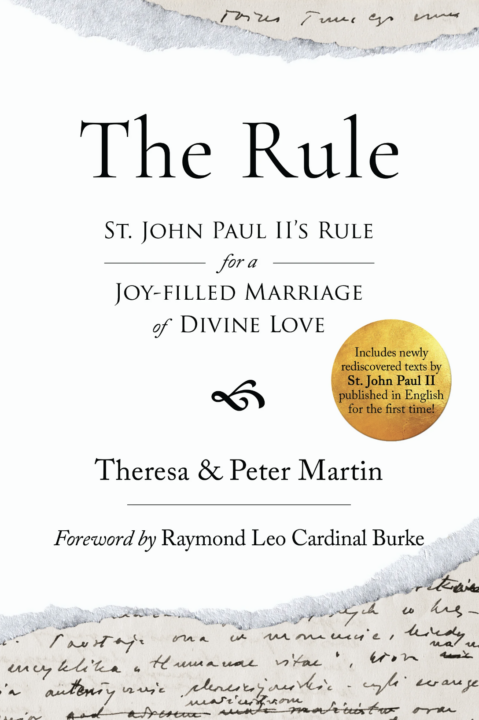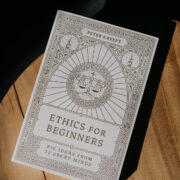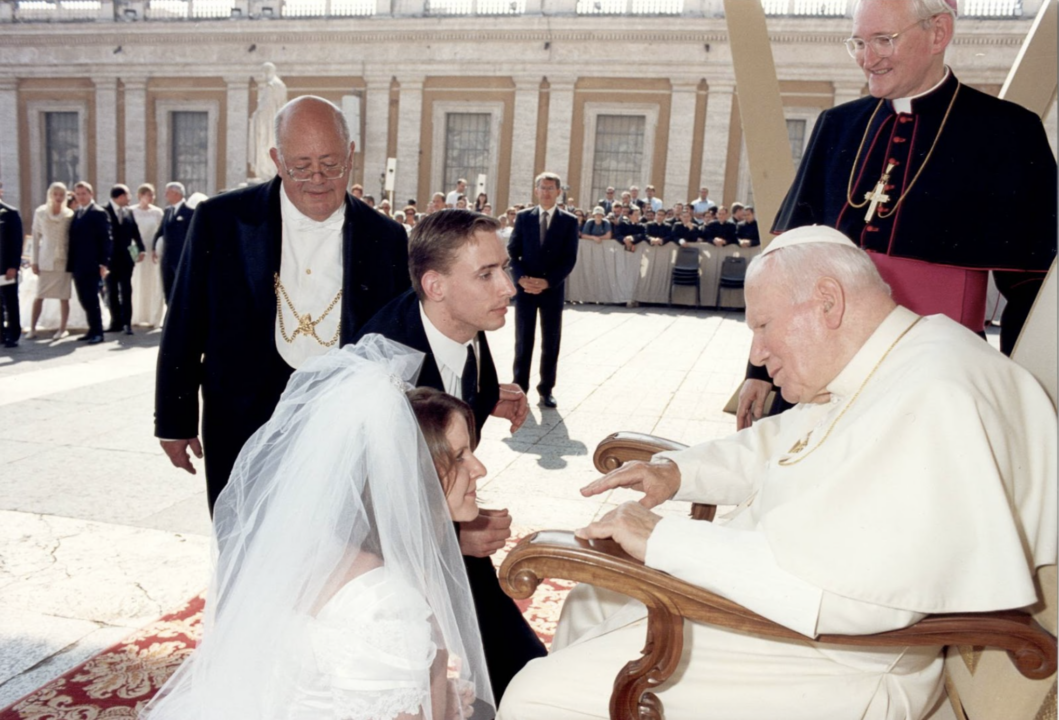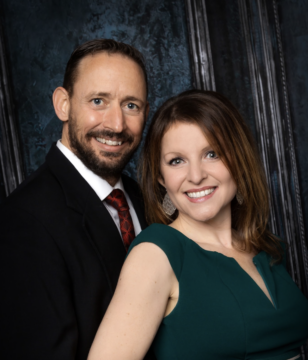Word on Fire’s Edyta McNichol sat down with Peter and Theresa Martin of the Wojtyła Community & Institute to discuss their new book, The Rule: St. John Paul II’s Rule for a Joy-Filled Marriage of Divine Love.

Q: This new book features recently rediscovered texts by John Paul II published in English for the first time. How did you first come across these texts, and what inspired you to turn them into a book?
A: The initial years of our married life took place studying theology in Rome. What a blessing that was! However, at the end of our fourth year, we had to leave in a bit of a hurry right after St. John Paul II died because of complications with the pregnancy of our firstborn. (We believe our baby was saved through St. John Paul II’s intercession, but that’s a story for another day!) Peter went on to complete his studies in Washington, DC, and Theresa joyfully began the grand adventure of mothering our children. It would be fourteen years later before another option would present itself, and Theresa was accepted into Maryvale’s remote study program (Maryvale Institute International Catholic College in Birmingham, England). When collaborating with the director about her dissertation topic, Theresa received a copy of the Italian book containing the Rule. The director said almost prophetically (though we didn’t know it then), “This has been waiting for you,” and placed the book in Theresa’s hands.
Using the Rule as the core text of her dissertation, she spent countless hours poring over it and the two accompanying texts included in our book. She shared her findings, and it resonated with Peter too. After her graduation, we thought, “St. John Paul II wrote a Rule for couples; we should do this! People need to know!” Yet, in the very next breath we’d think, “but who are we to do this?” We attempted to forget it and kept pushing it out of our minds, but like the Hound of Heaven, the Holy Spirit kept pursuing us until we finally understood: God was giving this mission to us. Despite being very aware of our own shortcomings, we finally said “yes!” This started a lengthy adventure, from founding a non-profit to acquiring the original documents in Polish for the direct translation to taking the remarkable findings from the dissertation and writing a book to receiving Vatican permission, etc., etc. Yet this work also brings us joy! As Bishop Barron often remarks, when you find your place in the theo-drama, you go “in haste”! What greater joy could we have than to do our little part in God’s great loving plan.
Holiness is about your surrender, giving your soul completely to God.
Q: The primary text that you explore in this book is a six-point Rule for married couples. What exactly is a “rule of life,” and how strictly are couples expected to abide by it?
A: In this context, the Rule would be a way of living or a set of guidelines to help direct your path, like a lantern on a dark road. When we first hear the word “rule,” it may give the impression of something negative or oppressive, but this is quite the opposite! St. John Paul II knew, even fifty years ago, that living the Christian faith in an increasingly anti-Christian culture would require a higher level of virtue than, perhaps, was required in past generations. We would need to live with heroic virtue, he says, to stand strong against the tidal wave of secularism. Yet it is extremely difficult to live at a continual level of heroic virtue. We would need help. This Rule was meant to be that help, to guide spouses to know “how” to live the truth. It is one thing to understand “why” something is true intellectually, but to know “how” to live it out in the messiness of everyday life is more challenging. The Rule is the key to unlocking that “how” and moving beyond the struggle to find lasting joy!
How strictly are couples expected to abide by the Rule? To answer that, we must remember that all of this must be understood within St. John Paul II’s personalistic vision of man. The integral vision of the person is seeing each person in who they are and who they are meant to be. We’ve coined this as “the real and the ideal.” The Rule is set forth by St. John Paul as the ideal path forward, which would include consistently gathering together with your married couple group. However, life happens and children get sick, extended family visit, whatever the case may be! This is each couple’s “real.” The couples continue to strive for the ideal, but accept and support each other when real life happens around them. No group is going to be perfect and all will have their real moments, but they keep encouraging one another on that journey toward the ideal, to what God has made each of us to be.
Q: John Paul II hoped that these writings would help married couples to live the truth of Humanae Vitae. Why is this encyclical so important, and what are its key points that John Paul wanted to reiterate?
A: Yes, the Rule’s purpose is to help couples “actuate” or make real within their everyday life the teaching of Humanae Vitae. In other words, the Rule helps to infuse their marriages with its truth and allow divine love to enter in, bringing indescribable joy. St. John Paul II saw Humanae Vitae as containing the core of all teaching on love and sexuality. It is so much more than the Church’s answer to the question of the use of contraception in marriage. On the contrary, he believed this encyclical gives us the conditions that will safeguard self-giving, authentic love and preserve the essence of authentic spousal love from falsification.
Even though Humanae Vitae was concise, he believed it was written with the integral vision of the person in mind. This personalism of St. John Paul II invites us to see every person we encounter in two moments: who they are and who they are meant to be. This allows us to be truly sympathetic and compassionate to the real situations and circumstances in which people find themselves and yet lovingly encourage each one toward becoming who God has made them to be. In this industrialized culture where our vision of self is as a producer or maker of things, the body can also be seen as something to be controlled or reshaped at will. One of the “safeguards” to authentic love is found at the very heart of the teaching of Humanae Vitae: the truth that God, and not man, is the author of marriage and human sexuality.
Q: A key aspect of the Rule is that it is meant to be lived in community with other couples. How important is community for growing in holiness?
A: The profound insight of St. John Paul II (especially in the Theology of the Body) gives us a multifaceted answer that adds up to a resounding, ‘Community is vital to growing in holiness!’ At the intimate level of our personhood, each and every one of us is made to be in communion with another. Our very existence is a gift, and God created us to love—that is, to make a gift of ourselves to another. As the Second Vatican Council underscored in Gaudium et Spes and St. John Paul II frequently quoted, “Man, who is the only creature on earth which God willed for itself, cannot fully find himself except through a sincere gift of himself.” How can one give himself as a sincere gift except through a community of persons? Simply stated, we need each other to become the holy women and men we were created to be! We were created for community, and in that community, we know ourselves and our destiny in Christ.

On another level, St. John Paul II recognized the shifting of the culture. He saw society moving away from Christendom (a cultural acceptance of the Judeo-Christian values) and toward an “increasingly anti-Christian culture.” Knowing the heroic virtue a Christian would need to live out their faith authentically in such a culture, he realized a Christian would be unable to sustain this level of virtue without the support of a genuinely Catholic community. The Rule lights the path for us to follow so that we no longer have to feel beaten down by secular culture. It can sometimes feel like we are white-knuckling our way through living our faith, because it is exhausting to endure the secular onslaught day after day. In one of the newly translated texts, St. John Paul II describes it as feeling like you are boxed into a dead end. With walls closing in on all sides, the Rule provides a crack through the wall to an expanse of joy and freedom like you’ve never imagined. It’s not instantaneous; it takes persistence and an opening to God’s grace, but the fresh air of joy in Christ you will experience is worth every effort!
Q: John Paul II speaks frequently of developing a “conjugal spirituality.” What does this mean, and how does he advise cultivating it?
A: In one of the texts newly translated in the book, St. John Paul II explains conjugal spirituality by describing the unique nature of the sacrament of marriage. He says that in every other sacrament, there is one person who enters into an “orbit of grace” with God. However, in the sacrament of marriage, two unique things occur. First, two people enter into this sacrament, into this union, and together in their spiritual union they enter into an “orbit of grace” with God. This creates a unique relationship with God and the spouses united. This new relationship does not change the personal relationship that they each have with God through Baptism but is a secondary relationship created through the grace of the sacrament. This is conjugal spirituality: this unique relationship the spouses, united as one, have with the triune God. The more spouses are open to the grace of the sacrament, the more conjugal spirituality unites them to each other and brings them closer to God. St. John Paul II said that the union possible for spouses could be so profound they have but one interior life between them!
The other unique element of the sacrament of marriage, he explains, is that the spouses confer the sacrament to each other. This giving one to another through their marital vows does not end at the altar on the wedding day. Spouses continue to give the sacrament to each other every day of their lives. In this way, the spouses become the conduit of the “action of God” in their marriage. Their conjugal spirituality makes this union possible. This conjugal spirituality isn’t something that happens only on the kneelers but in every aspect of their married life. You’ll have to read the book to learn more about this profound gift, but following the Rule allows spouses to put more focus on their marriage and to learn to open their hearts to this grace on a daily, even moment-by-moment basis.

Q: You’ve mentioned a few times already John Paul II’s emphasis on the “integral vision of the person.” Why is this insight so important to married life?
A: Every person is flawed and, much to our own chagrin, continues to make mistakes and fall into sin. Yet, we desire to be holy and have a difficult time reconciling the two. St. John Paul II shows us that real growth in holiness happens right in the middle of this messy tension. It is easier to fall to an extreme. On the one hand, we may see our reality of failures and difficulties and fall into despair, entirely giving up on seeking the ideal. On the other hand, we may whitewash our own failings and act in a way that seems to be the ideal without vulnerably allowing God into those parts of our soul that need his help. The path to holiness is only in the messy tension: the humble acknowledgement of the real within ourselves and our own marriage (even being able to laugh at ourselves!), and still seeking the ideal God has made us to be every single day.
The reaction to the teaching of Humanae Vitae seems to break down this line. Either we are focused too much on the real: “you have a very difficult marital situation and this is not easy, so don’t worry about this teaching; it’s too difficult”; or we are too focused on the ideal: “it doesn’t matter what your situation is, this is the truth, suck it up and live it.” Neither one allows the couple to grow in holiness. In the first example, they don’t even seek holiness. In the second, their personal situation is just dismissed entirely, which could cause hurt and resentment. They may force their way forward, but they will not find joy. Instead, St. John Paul II encourages listening to couples and being compassionate to their struggles. Yet, don’t leave each other there—share the joy of Christ: the hope of his love giving us strength to overcome every obstacle! Striving for holiness in this way is greatly facilitated by Married Couple Groups who trust each other enough to be vulnerable and are committed to helping each other grow in conjugal spirituality.
It takes some figuring out to shift from reading the book to letting the book read you and your marriage.
Q: On a more practical note, John Paul II highlights the importance of prayer and apostolate. How do these benefit both married couples and their respective communities?
A: Prayer is of the utmost importance in following the Rule. We begin our Married Couple Group meetings with prayer, end with prayer, and are encouraged to pray for each other and all marriages throughout the week. Prayer is our lifeline, in our marriage and in our communities. The call for an apostolate serves to keep the joy and love of the group alive and life-giving! When St. John Paul II was a young priest and the group of students began to form around him, going outward in love and service was important to the life of their community. Authentic love is self-giving; it wants to break forth to others. Love that is not giving begins deteriorating. What was once a fun, thriving community becomes a closed-in clique unwilling to grow, unwilling to share their joy with others. Joy that is not shared diminishes.
Q: At the heart of the Rule is the belief that all married couples are called to radical holiness and relationship with God. Can you speak to this insistence upon the universal call to holiness?
A: St. John Paul II was aware that only Christ could bring us true peace and true joy. By the very fact of his canonizing 482 saints and 1,341 blesseds, you could say that highlighting the universal call to holiness was a goal of his pontificate. Among those who were beatified were Luigi and Maria Quattrocchi, the first married couple ever to be beatified together. At the beatification, St. John Paul II said, “The riches of faith and love of the husband and wife Luigi and Maria Beltrame Quattrocchi, are a living proof of what the Second Vatican Council said about the call of all the faithful to holiness, indicating that spouses should pursue this goal, ‘propriam viam sequentes,’ ‘following their own way.’ Today the aspiration of the Council is fulfilled with the first beatification of a married couple: their fidelity to the Gospel and their heroic virtues were verified in their life as spouses and parents.” St. John Paul’s homily given on that day, which was also the twentieth anniversary of Familiaris Consortio, shows us exactly why he insists on emphasizing the universal call to holiness, particularly to married couples.
Q: You mention in the book that this Rule inspired you to create the Wojtyła Community & Institute, which offers formation and community for married couples. Tell us more about why you decided to start this institute and what you hope to offer through it.
A: The Rule is such a treasure; a gift, left sitting on a shelf for decades, waiting for the perfect time to be taken down and unwrapped. We hope that through the book, people can read the Rule, learn about it, and get excited about the possibility of joy God has for their life! Reading the book gives you the “head knowledge,” but actually putting it into practice and living out the Rule takes place in a Married Couple Group. This is where the heart learns. It takes some figuring out to shift from reading the book to letting the book read you and your marriage. Working to understand St. John Paul II’s vision for these groups, what the best method to apply it might be, how to do all this while keeping always in mind the integral vision of the person—these are all part of the nuances the Wojtyła Community & Institute (WCI) has worked on! The mission of the WCI is to share the Rule and support those couples wanting to live it out. Ultimately, we would love to see a surge of Married Couple Groups grow throughout the English-speaking world (and beyond), and the WCI is ready to support these couples with workbooks, conjugal spirituality journals, retreat options, mentorship for leader couples, and more! We look forward to assisting you to live heroically and not be afraid!

Q: What have you personally learned in the process of researching and writing this book?
A: The answer to that question is probably the length of another book itself! God is so good, so merciful, so gracious to his littlest children! In a previous question, we spoke about the universal call to holiness and how St. John Paul II kept insisting on it. What we’ve realized is that it isn’t about how worthy you are. You aren’t chosen for a particular mission or vocation because somehow you’re holy enough. God choosing you makes you worthy of it—that’s it! Instead, holiness is about your surrender, giving your soul completely to God.
When we said yes to the mission of the Rule, we not only wrote a book and started a nonprofit but also started the very first Married Couple Group living the Rule. What we were drawn to most was that lasting joy and profound unity that St. John Paul II spoke of. Movements of the heart, as we all know, take time to mature. We were opening our spousal relationship more and more to God, asking him to take us where he wants us to be. And the change in the day-to-day living is almost imperceptible, like watching a child grow. Yet we look back over the last year or two and are amazed at what God can do! We have always had a strong, faithful marriage, but we can both confidently say that God has brought our marriage even more peace, more love, and more joy than before! We can’t wait to see what he does with our marriage in the next twenty one years!
